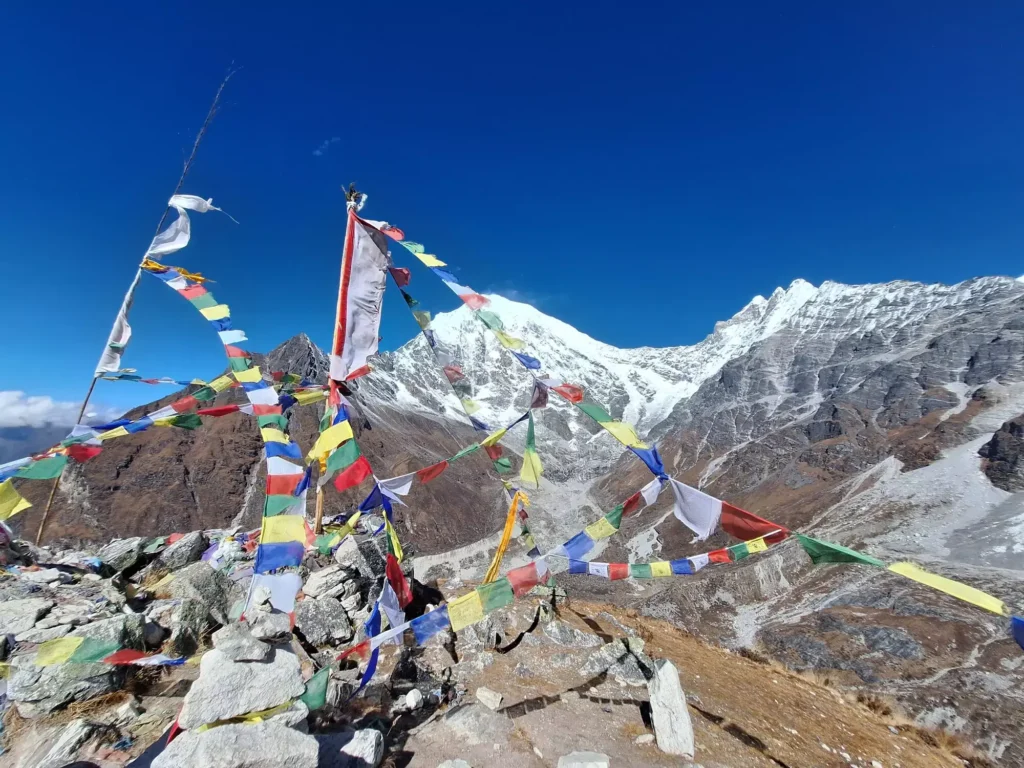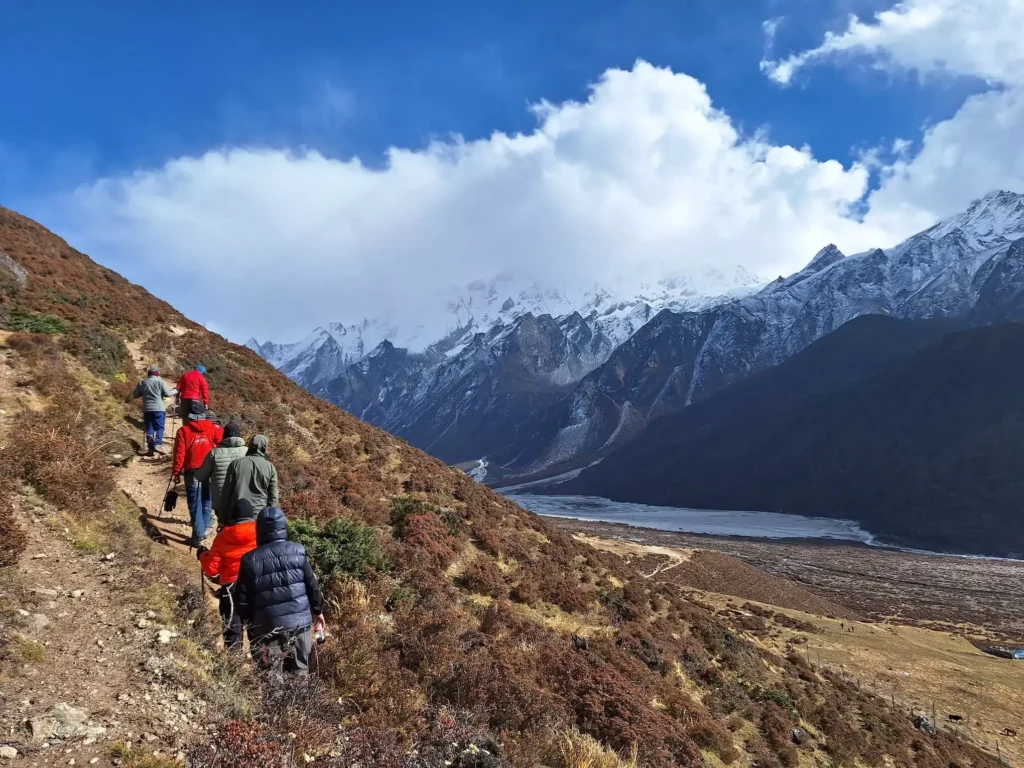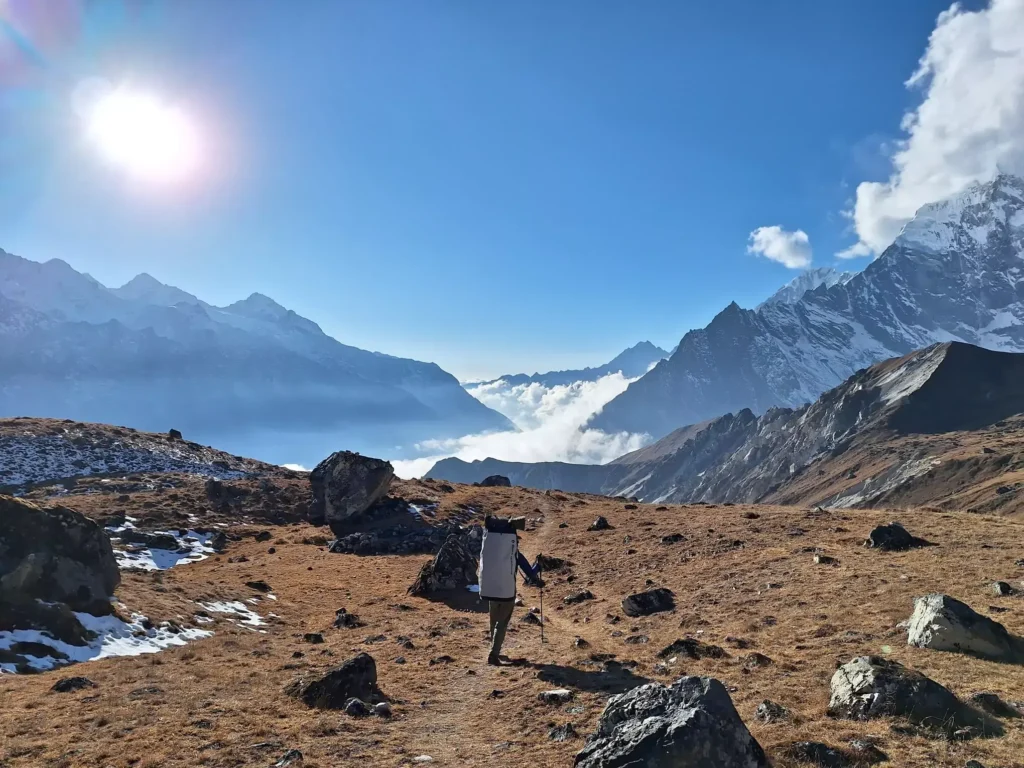Duration
10 Days
Max. Altitude
4984m
Difficulty Level
Moderate
One Way Distance
58Km
Start/End Point
Kathmandu
Best Season
Autumn/Spring
Duration
10 Days
Max. Altitude
4984m
Difficulty Level
Moderate
One Way Distance
58Km
Start/End Point
Kathmandu
Best Season
Autumn/Spring
Overview
The Langtang trek is where the true soul of the Himalayas quietly reveals itself. Located in the Langtang region of the Himalayas, north of Kathmandu, this region feels like it’s been gently cradled by nature for centuries. The trek offers you breathtaking mountains, lush green forests, and quiet villages that seem frozen in time.
The trek unfolds within Langtang National Park, Nepal’s first Himalayan national park and a sanctuary of incredible biodiversity. On the trail, you will be walking through quiet Tamang and Tibetan villages where prayer flags wave over the paths and warm smiles greet you like family. These communities carry stories in their eyes, resilience in their hearts, and a deep-rooted connection to the land that makes the experience feel both personal and powerful.
The journey to Langtang takes 10 to 12 days, the perfect time to enjoy nature and the stories the wind, rivers, and old paths tell. Each day leads you deeper into the valley, eventually bringing you to the spectacular heights of Kanjin Ri at 4773 meters and Tserko Ri at 4984 meters. After reaching these viewpoints, it feels like standing at the edge of the world, with endless Himalayan giants stretching into the sky.
Once devastated by the 2015 earthquake, Langtang has risen with renewed strength and spirit. The rebuilt trails and lodges now stand as a powerful reminder of the community’s resilience and the region’s quiet determination to heal and thrive.
For anyone planning to trek in Nepal, Langtang is more than just a route; it’s that perfect combination of wilderness and warmth, of adventure and inner peace. It can be your first or even your fifth visit to the Himalayas, but Langtang has a way of making you fall in love with the mountains once more.
Highlights of Langtang Trek
- Enjoy mesmerising views of snow-capped Himalayan peaks, lush green landscapes, and peaceful alpine meadows.
- Trek through a stunning valley surrounded by towering mountains and traditional Tamang villages rich in cultural heritage.
- Visit a serene Tibetan Buddhist monastery with panoramic mountain views and access to side trips like Kanjin Ri and Tserko Ri.
- Walk through varied ecosystems, from dense forests to open meadows, home to unique wildlife and vibrant bird species.
- Experience authentic Tamang and Tibetan traditions through village life, ancient monasteries, and religious ceremonies.
- Suitable for most trekkers, offering a fulfilling Himalayan adventure with manageable difficulty.
- Reach Kanjin Ri at 4773 meters and Tserko Ri at 4984 meters for unforgettable panoramic vistas.
Trek Itinerary & Route Map
Day 01Arrival in Kathmandu (1,400 m / 4,593 ft)
Welcome to Nepal. Your journey begins in Kathmandu. Once you land at Tribhuvan International Airport, our team will greet you and transfer you to your hotel in the city. This day is perfect for resting after your flight. If you have time, stroll through Thamel’s bustling streets or explore Kathmandu Durbar Square. Kathmandu’s fusion of ancient temples, vibrant culture, and friendly locals makes it an exciting introduction to Nepal before you head for the trip.
Day 02Drive from Kathmandu to Syabru Besi (1,503 m / 4,931 ft)
Your adventure begins with a scenic drive through winding mountain roads, lush hills, and rural villages. Syabru Besi sits beside the Bhote Koshi River and is known as the gateway to Langtang Valley. The journey takes approximately 7 to 9 hours, offering incredible views of terraced farms and river valleys. This peaceful village is a blend of natural beauty and Tamang culture.
Day 03Trek from Syabru Besi to Lama Hotel (2,500 m / 8,202 ft)
Today marks the start of your actual trek. You’ll follow a peaceful forest trail alongside the Langtang Khola, crossing several suspension bridges. The trail ascends gradually through oak and rhododendron forests, creating a tranquil atmosphere. The walk takes about 5 to 6 hours and leads you to Lama Hotel, a quiet resting place surrounded by dense greenery.
Day 04Trek from Lama Hotel to Langtang Village (3,430 m / 11,253 ft)
As you continue your journey, the forest begins to thin and mountain vistas open up. The trail passes through charming settlements like Ghoda Tabela and Thangshyap, offering a glimpse of local mountain life. After 5 to 6 hours of trekking, you’ll arrive at Langtang Village, a resilient community rebuilt after the 2015 earthquake. The village offers a deep sense of culture and perseverance.
Day 05Trek from Langtang Village to Kyanjin Gompa (3,830 m / 12,566 ft)
Today’s trail is filled with spectacular views of glaciers and towering peaks. You’ll pass many walls and prayer wheels as you approach Kyanjin Gompa, a serene Buddhist village. The hike takes about 4 to 5 hours. Upon arrival, take time to visit the ancient monastery or explore the local yak cheese factory while surrounded by dramatic Himalayan scenery.
Day 06Acclimatization and trek to Kyanjin Ri (4,773 m / 15,659 ft) or Tserko Ri (4,984 m / 16,352 ft)
This is your acclimatization and exploration day. You can choose between two breathtaking viewpoints:
- Kyanjin Ri takes about 4 to 5 hours and offers sweeping views of Langtang Lirung and surrounding peaks.
- Tserko Ri is a longer 6- to 7-hour round trip with a more challenging ascent, but the views of the entire Langtang range are unforgettable.
Either option rewards you with a profound sense of peace and achievement at the heart of the Himalayas.
Day 07Trek from Kyanjin Gompa to Lama Hotel (2,500 m / 8,202 ft)
You’ll retrace your steps back down the valley, passing through Langtang Village and enjoying familiar landscapes from a new perspective. The descent is easier and allows you to fully appreciate the beauty you hiked through earlier. The walk takes about 5 to 6 hours.
Day 08Trek from Lama Hotel to Syabru Besi (1,503 m / 4,931 ft)
This final trekking day is a gentle return through forests and riverside trails. The 5- to 6-hour journey allows time to reflect on the path you’ve covered and the memories you’ve made. Reaching Syabru Besi again feels like coming full circle in the Himalayas.
Day 09Drive from Syabru Besi to Kathmandu (1,400 m / 4,593 ft)
You’ll drive back to Kathmandu through the familiar winding roads and hills of rural Nepal. The return trip takes around 7 to 9 hours, with chances to stop for scenic photos or a warm local meal. Back in the capital, enjoy one last evening immersed in Nepalese culture.
Day 10Final Departure from Kathmandu
After breakfast, you’ll be transferred to Tribhuvan International Airport for your departure. As you leave, you’ll carry memories of towering peaks, warm-hearted villagers, and the quiet magic of Langtang Valley a journey that touches both body and soul.
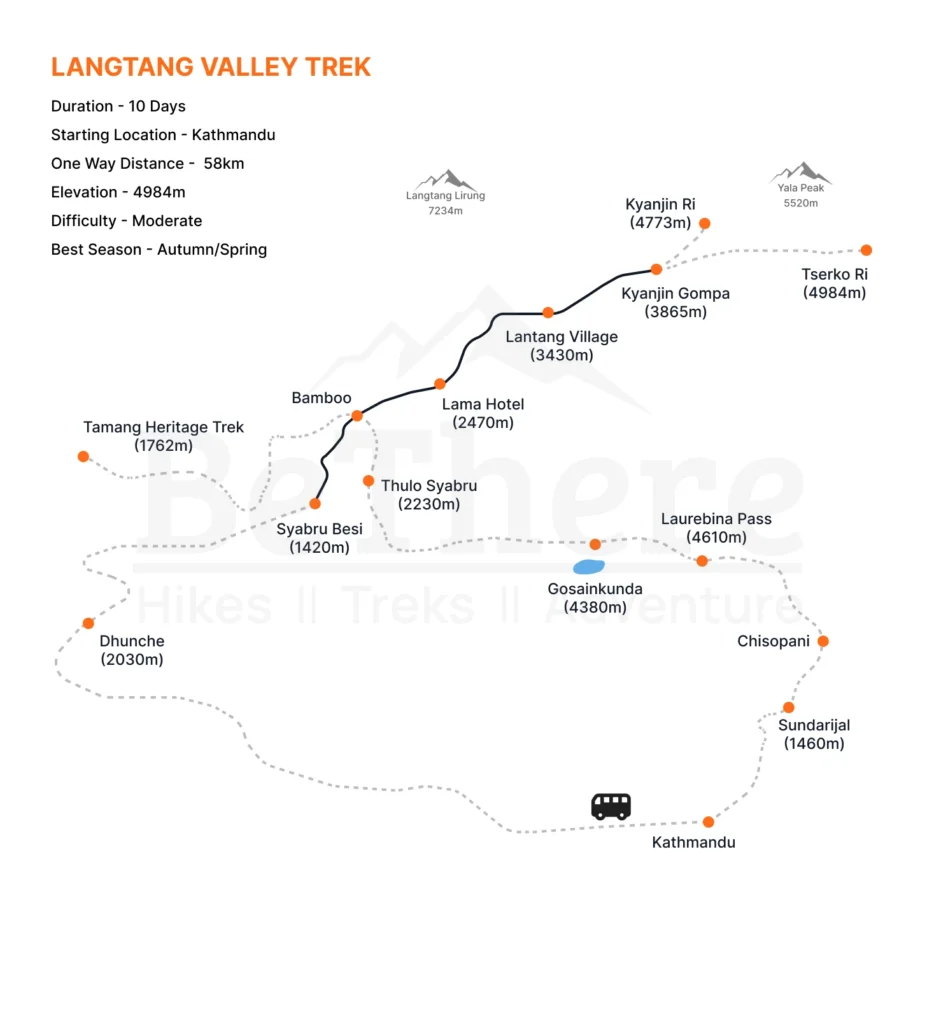
Includes/Excludes for Annapurna Circuit Trek
- Arrival & Departure Transfers: Pick-up and drop-off service between Tribhuvan International Airport and your hotel in Kathmandu.
- Accommodation in Kathmandu: Hotel accommodation on a bed & breakfast basis in a twin-sharing room at a standard hotel in Kathmandu.
- Trekking Permits: All required permits, including National Park entry, TIMS (Trekkers' Information Management System), and conservation area fees.
- Insurance for Staff: Full insurance coverage for all Nepali staff involved during the trek.
- Transportation: Domestic Flights: Round-trip airfare from Kathmandu to the trekking starting point and back, including guide airfare.
- Equipment Transport: Transportation of all necessary trekking equipment and staff gear.
- Personal Baggage Allowance: Up to 15 kg of personal luggage per trekker, carried by porters.
- Meals & Lodging During the trek: Three meals a day (breakfast, lunch, and dinner) and comfortable lodging at local hotels or lodges along the trekking route.
- Guide and Porters: One professional English-speaking trekking guide and porter service (1 porter per 2 trekkers).
- Staff Wages and Allowances: All wages, meals, accommodations, and insurance for Nepali staff during the trek.
- First Aid Kit: Basic medical kit carried by the guide for emergency situations.
- International Flights: Your flight to and from Nepal is not included.
- Nepal Entry Visa: You must get a visa upon arrival at Kathmandu airport or online in advance.
- Meals in Kathmandu: Lunch and dinner while staying in Kathmandu or in case of early return from the trek.
- Extra Nights in Kathmandu: Any extra hotel nights in Kathmandu due to early arrival, late departure, or returning from the trek ahead of schedule.
- Emergency Rescue & Insurance: Personal travel insurance, emergency evacuation/rescue services, and Medical expenses
- Personal Expenses: Phone calls, internet, battery charging, hot showers, laundry, boiled water, and alcoholic or bottled beverages. Personal clothing, trekking gear, a medical kit, and packing supplies.
- Tips: Gratuities for your guide, porter, and trekking staff (optional but appreciated).
Note
Please note that due to ongoing road construction along the Prithvi Highway, the drive from Kathmandu to Pokhara has become more time-consuming and dusty than usual. While this journey typically takes around 6–7 hours, current conditions may extend it to 8–9 hours due to traffic congestion and air pollution. We kindly ask for your patience and understanding during this transitional period.
Gear Checklist for Langtang Trek
Item
Quantity
Four-season (zero-degree) sleeping bag
1
Puffy down jacket
1
Daypack (35–45 liters recommended) with rain cover
1
Sleeping bag liner
1
Sun hat or cap
1
Knitted hat
1
Headlamp
1
Sunglasses
1
Technical fabric base layer (upper body)
1
Technical fabric short-sleeve shirts
2
Technical fabric long-sleeve shirts
2
Waterproof, windproof shell (jacket)
1
Fleece jacket or pullover
1
Technical fabric base layer (lower body)
1
Hiking pants
2
Comfortable pants for inside teahouses
1
Waterproof, windproof shell (pants)
1
Hiking shorts
1
Wool or technical fabric liner gloves
1 pair
Hard-shell outer gloves (insulated)
1 pair
Wool or technical fabric warm socks
–
Hiking socks
_
Liner socks (optional)
–
Trekking/hiking boots (waterproof recommended)
1 pair
Ice cleats/micro spikes
1 pair
Casual shoes
1 pair
Gaiters (light or heavy depending on season)
1 pair
Quick-dry underwear
–
Sports bras (women)
_
Pajamas or sleeping clothes
1 set
Sunscreen
1
Lip balm
1
Antibiotic ointment
1
Bandages (including blister-specific bandages)
–
Acetazolamide tablets (for altitude sickness—consult doctor
_
Painkiller tablets
_
Bismuth subsalicylate (for indigestion or diarrhea)
_
Passport
1
Extra passport-sized photos
_
Reusable water bottle
1
Toiletry kit
1
Water purification tablets or UV water purifier
1
Hydration bladder
1
Towel
1
Pillowcase
1
Toilet paper
2 rolls
High-protein snacks (e.g., protein bars or nuts)
_
Waterproof/dry bags (for documents and money)
_
Airline tickets (copy left at Kathmandu office recommended)
1
General Information
- Wear warm clothing; a down jacket is essential above 4,000 m (rental: USD 30–40; damage/loss: USD 150).
- A 4-season sleeping bag is necessary for cold nights (rental: USD 30–40; damage/loss: USD 150).
- Spend a few days in Kathmandu to help your body acclimatize to high altitudes.
- Wear well-broken-in trekking shoes with good grip to avoid blisters and discomfort.
- Pack in layers and bring waterproof gear for changing mountain weather.
- Use trekking poles for added stability and to reduce pressure on knees.
- Stay hydrated and carry water purification tablets or a filter.
- Bring essential toiletries like wet wipes, hand sanitizer, and toilet paper.
- Be in good physical shape; train regularly before the trek.
- Respect local culture by dressing modestly and avoiding handouts to children.
- Enjoy the trek, take photos, and immerse yourself in the scenery and traditions.
FAQs
1. What is the Langtang Trek altitude?
The Annapurna Circuit Trek is considered moderately to highly challenging. It involves several days of walking, steep climbs, and high altitudes. With good preparation and acclimatization, most trekkers with average fitness can complete it.
2. How long is the Langtang Trek?
The Langtang Valley Trek typically takes 10 to 12 days, depending on the itinerary, acclimatization days, and individual pace. The journey usually starts and ends at Syabru Besi, with highlights like Kyanjin Gompa, Kyanjin Ri (4,773 m), and Tserko Ri (4,984 m).
3. How difficult is the Langtang Trek?
The Langtang Trek is considered moderate in difficulty. It doesn’t require technical climbing skills, but trekkers should be in decent physical shape due to the continuous walking at high altitudes and steep sections. Daily trekking lasts 5 to 7 hours, and proper acclimatization is important.
4. How do I get to the Langtang Trek from Kathmandu?
To reach the Langtang trekking region from Kathmandu, you’ll take a scenic 7- to 9-hour drive to Syabru Besi, the starting point of the trek. This drive passes through hills, rivers, and charming rural villages, giving you a glimpse of Nepal’s natural beauty before you even begin your trek. The return to Kathmandu follows the same road route.
5. What’s the best time to do the Langtang Trek?
The best seasons for the Langtang Trek are autumn (September to December) and spring (March to May). Autumn offers clear skies, fresh post-monsoon air, and excellent mountain views, while spring brings stable weather, comfortable temperatures, and pleasant trekking conditions.
6. Do I need a permit for the Langtang Trek?
Yes, you’ll need a couple of permits for the Langtang Trek. These include the Langtang National Park entry permit, the TIMS card (Trekkers’ Information Management System), and a conservation area entry fee. All these permits are usually arranged by your trekking company and are included in your trek package.
7. What essentials should I pack for the Langtang Trek?
For the Langtang Trek, it’s important to pack layered clothing, including a warm-down jacket, waterproof gear, and proper hiking boots. A four-season sleeping bag, headlamp, trekking poles, toiletries, and a water bottle or hydration bladder are also necessary. Don’t forget sunscreen, first aid items, and personal medications. You can also rent a down jacket and sleeping bag in Kathmandu if needed, but note the replacement cost in case of loss or damage.
8. Will I have cell phone or internet access during the Langtang Trek?
Cell phone and internet access can be limited and inconsistent during the Langtang Trek, especially in higher altitudes like Kyanjin Gompa. Some tea houses may offer paid Wi-Fi, but it’s not always reliable. It’s best to inform family and friends in advance and focus on enjoying the natural surroundings during your trek.
9. Is the Langtang Valley Trek safe?
Yes, the Langtang Valley Trek is safe today. The trails have been rebuilt and improved since the 2015 earthquake, and local communities are well-prepared to host trekkers again. Guesthouses are operational, guides are experienced, and safety protocols are followed. As with any high-altitude trek, it’s important to be properly acclimatized and trek with a licensed guide or agency for the best experience.
10. How is Langtang Valley now?
Langtang Valley has bounced back beautifully from the tragedy of 2015. The natural beauty remains untouched; towering peaks, serene landscapes, and rich cultural villages await trekkers with open arms. The rebuilt trails and teahouses now reflect both the resilience of the local people and the continued charm of one of Nepal’s most beloved trekking destinations. Langtang today is not only a place of adventure but also one of hope and renewal.
Need help with your trek?
Reach out to our travel experts
All Inclusive Pricing
USD $900 $600 / Minimum 2 Pax
Plan Your Hike

Nepal🇳🇵
What Trekkers are Saying About Us
Bhasmasur Hill was challenging but rewarding with its stunning views. Subash Ghimire’s tips about local culture and nature brought the hike to life for me. It felt like a real adventure, and his friendly attitude kept the group motivated.

Timo Janssen
Traveler from Netherlands
Shivapuri Peak was a perfect challenge for me, tough enough to feel like an accomplishment, but the views were worth every step. The whole experience was seamless thanks to BeThere. They took care of all the planning, so I could just enjoy the hike and nature.

Hannah Brooks
Traveler from USA
Bishnudwar was a quiet, beautiful hike, just what I needed to get away from the daily grind. Alexander Lama knew all the best spots for photos and even pointed out some wildlife. I couldn’t have asked for a better guide.

Nathan James
Traveler from New Zealand
The trail to Nagi Gumba was peaceful and absolutely stunning. BeThere fun made the trip feel so organized and stress-free, from start to finish. I loved being surrounded by nature, just a short drive from Kathmandu.
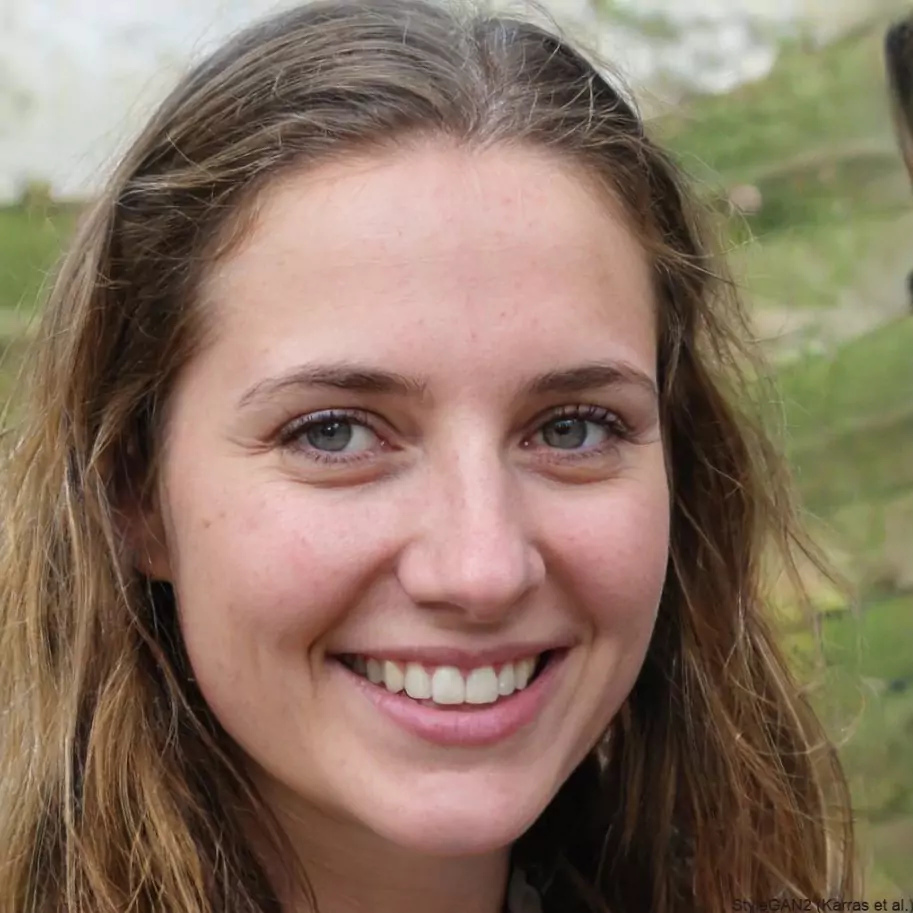
Rachel Bennett
Traveler from UK
Nagarkot was everything I hoped for beautiful forest trails, fresh air, and incredible valley views. The trip was well arranged by BeThere, which allowed me to relax and focus on the experience without any worries.

Felix Schmidt
Traveler from Germany
Lobuche Peak was intense but rewarding. Subash Ghimire made sure we were ready for the climb and kept spirits high with his friendly attitude. This was one of my favorite trekking experiences by far.

Giulia Bianchi
Traveler from Italy
Need help choosing a trail?
Connect with a local and plan your perfect trek.
